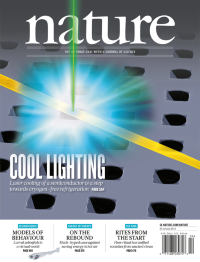Volume 493
-
No. 7434 31 January 2013
Pleasant stimulation of skin serves important social functions in mammals, but has received less attention from molecular neurobiologists than the response to noxious stimuli. Now David Anderson and colleagues have used calcium imaging in live mice to show that a small population of sensory neurons in hairy skin � expressing the G-protein-coupled receptor MRGPRB4 � responds specifically to strokes from a small paintbrush intended to simulate natural stroking or grooming, but not to pinching or poking stimuli, which activate a different population of sensory neurons expressing MRGPRD. Pharmacological stimulation of MRGPRB4+ neurons elicits positive reinforcing behavioural effects. The stroke-sensitive� neurons resemble C-tactile afferents, unmyelinated mechanoreceptive neurons found in hairy skin of humans and other mammals. The functional characterization of this novel population of neurons opens the way to identifying molecular transduction mechanisms and neural circuitry associated with a positive affective state � or pleasure. On the cover, monkeys by a river in Angkor, Cambodia (Roberto Westbrook/Blend Images/Corbis).
-
No. 7433 24 January 2013
Laser cooling of solids, or optical refrigeration, is attractive as a route to compact, cryogen-free and vibration-free refrigeration devices. Laser cooling, based on removing heat due to blue-shifted emission, has been reported previously in rare-earth-metal-doped glasses and crystals. Now Jun Zhang et al. demonstrate a substantial net laser cooling of a semiconductor CdS nanobelt � by about 40 K from 290 K pumped by a 514-nm laser. This achievement opens up a route to optical refrigeration based on semiconductors, where the mechanisms involve excitonic rather than atomic resonances. Laser cooling media based on II VI semiconductors are potentially highly efficient, capable of achieving extremely low temperatures and readily integrated into optoelectronic devices. On the cover, a false-colour scanning electron micrograph of a suspended CdS nanobelt with a representation of luminescence up-conversion pumped by a green laser.
-
No. 7431 10 January 2013
Large parts of the EarthEs surface were glaciated during the Quaternary cold periods of the past 2.5 million years, and these events have left their mark on the mountain topography we see today. Post-glacial landscapes tend to feature large areas concentrated at the same elevation, but the effect of this on subsequent glaciations was unknown. Vivi Pedersen and David Egholm use numerical simulation of glaciation and case studies of alpine topography of the Sierra Nevada, Spain, where there was little glacial activity in the Quaternary, and the Bitterroot Range in Idaho, which was significantly modified by glaciers during the Quaternary. The results show that prior glaciations transform a system from one in which climate exerts a near-linear influence on glacial extent to one in which a small change in climate can result in massive glacial expansion. This helps to explain the long-term patterns of erosion in the Quaternary period. (Cover image: Nicolaj Krog Larsen, Aarhus University.)
-
No. 7430 3 January 2013
Giant spiral galaxies are assembled from smaller systems through a process known as hierarchical clustering. In orbit around these giants are dwarf galaxies, which are presumably remnants of the galactic progenitors. Recent studies of the dwarf galaxies of the Milky Way have lead some astronomers to suspect that their orbits are not randomly distributed. This suspicion, which challenges current theories of galaxy formation, is now bolstered by the discovery of a plane of dwarf galaxies corotating as a coherent pancake-like structure around the Andromeda galaxy, the Milky Ways close neighbour and in many respects its twin�. The structure is extremely thin yet contains about half of the dwarf galaxies in the Andromeda system. The authors report that 13 of the 15 satellites in the plane share the same sense of rotation. On the cover, a true colour image of the Andromeda galaxy, with two satellite galaxies visible, by Jean-Charles Cuillandre (CFHT) and Giovanni Anselmi (Coelum Astronomia).





